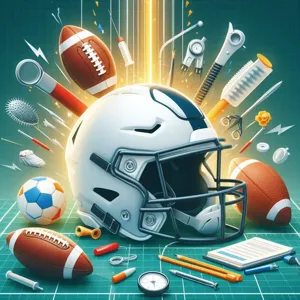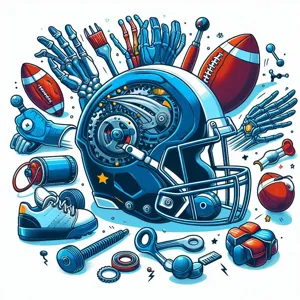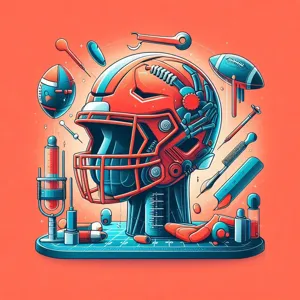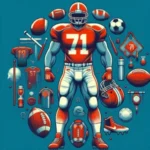In the world of football, safety is paramount, and the helmet is one of the most critical pieces of equipment designed to protect players on the field.
With advancements in technology and design, modern football helmets have evolved significantly, incorporating innovative features that aim to minimize the risk of injury while maintaining peak performance. From the sleek contours that enhance aerodynamics to the advanced padding systems that absorb impact, each design element plays a vital role in safeguarding athletes during high-stakes games. In this blog post, we will break down the intricate anatomy of football helmets, exploring how different designs function to protect players from the harsh realities of the sport. Join us as we delve into the engineering marvels behind these protective gears, examining the science of impact absorption, ventilation, and comfort, all while highlighting the importance of choosing the right helmet for players at every level.
1. Introduction to Football Helmets and Their Importance

Football helmets are not just a piece of equipment; they are a critical component of player safety in one of the most physically demanding sports. Designed to absorb and disperse the force of impacts, helmets play a pivotal role in protecting players from traumatic brain injuries and other severe head trauma. The evolution of helmet design reflects a growing understanding of the mechanics of concussions and the need for enhanced protection on the field.
In the high-speed, high-impact world of football, the risks are ever-present. Every tackle, block, and collision can lead to potential injuries that might have lifelong consequences. This reality has pushed manufacturers to innovate continuously, creating helmets that not only meet stringent safety standards but also offer advanced features tailored to mitigate the risk of injury. With various styles and technologies available, players, coaches, and parents must understand what makes a football helmet effective and how different designs can influence the level of protection afforded to the athlete.
From the outer shell materials that provide durability and resistance to abrasions, to the interior padding designed for energy absorption, each element of a helmet is meticulously engineered. In this blog post, we will delve into the intricate details of football helmets, exploring how various designs work to safeguard players and the innovations that are shaping the future of football safety. Understanding these elements is crucial not only for players and their families but also for coaches and sports organizations dedicated to promoting the health and well-being of athletes. As we break down the components of football helmets, we will highlight the importance of selecting the right helmet, keeping the player’s safety at the forefront of the game.
2. The Evolution of Football Helmet Design
The evolution of football helmet design is a fascinating journey that reflects both advancements in technology and a deeper understanding of player safety. In the early days of the sport, helmets were little more than leather caps, offering minimal protection against the brutal impacts of the game. These rudimentary designs were often ill-fitting and lacked the cushioning necessary to absorb shocks, leaving players vulnerable to head injuries.
As players became bigger, faster, and stronger, the need for more effective protection became evident. The 1950s marked a significant turning point with the introduction of plastic helmets, which not only provided a sturdier barrier against impact but also allowed for better customization and comfort. These innovations laid the groundwork for the helmets we see today.
Throughout the following decades, manufacturers began to incorporate advanced materials like polycarbonate shells and energy-absorbing foam linings. These materials helped to dissipate the force of collisions, significantly reducing the risk of concussions and other head injuries. The 1980s and 1990s saw the introduction of facemasks and chin straps, which not only enhanced safety but also improved visibility and breathability for players.
Today, the design of football helmets continues to evolve, driven by cutting-edge research and technology. Modern helmets are equipped with features such as impact sensors that provide real-time data on the severity of impacts, allowing coaches and medical staff to make informed decisions about player safety. Additionally, many helmets now undergo rigorous testing to meet safety standards set by organizations like the National Operating Committee on Standards for Athletic Equipment (NOCSAE).
As we look to the future, the focus on player safety will only intensify, with ongoing innovations aimed at further reducing the risk of injury. The evolution of football helmet design not only reflects the changing dynamics of the sport but also highlights a collective commitment to protecting athletes while allowing them to perform at their best.
3. Understanding the Anatomy of a Football Helmet

To truly appreciate how football helmets function, it’s essential to understand their anatomy. A football helmet is not just a solid piece of equipment; it is a carefully engineered device designed to absorb impact and protect players from traumatic injuries.
At first glance, a helmet may appear to be a simple hard shell, but it comprises several critical components that work together to enhance safety. The outer shell, typically made from a durable plastic such as polycarbonate, serves as the first line of defense against external forces. This hard exterior is designed to withstand impacts, helping to disperse the energy from hits that players encounter on the field.
Beneath the outer shell lies the inner foam padding, which plays a pivotal role in absorbing shock. This padding is often made from expanded polystyrene (EPS) or other advanced materials designed to compress upon impact, thereby reducing the force transmitted to the player’s head. The thickness and density of this padding can vary depending on the helmet’s design and intended use, with many manufacturers continually innovating to enhance its protective capabilities.
The helmet also features a protective faceguard, which protects the face from direct impacts while allowing for visibility and breathability. Designed with various configurations—ranging from full cages to simpler visors—the faceguard is engineered to withstand significant force without compromising the player’s vision or ability to communicate on the field.
Another crucial element of helmet design is the retention system, which includes the chin strap and internal padding that keeps the helmet securely in place during play. Proper fit is essential, as a helmet that shifts during impact can expose the player to serious injury. Modern helmets often include adjustable features to ensure comfort and stability, accommodating the varying head shapes and sizes of players.
Finally, many helmets now incorporate advanced technologies, such as sensors that can track impacts in real-time, providing vital data that can help improve safety standards and inform training practices. This integration of technology signals a shift towards a more proactive approach to player safety, allowing teams to monitor and assess risk factors more effectively.
Understanding the anatomy of a football helmet reveals the intricate design and engineering that prioritize player safety. By appreciating these components, coaches, players, and parents can make informed decisions about helmet selection, ensuring that athletes are well-protected as they compete on the field.
4. Key Features of Modern Football Helmets
Modern football helmets have undergone significant evolution over the years, incorporating advanced technology and design features aimed at maximizing player safety. Here are some key features that define the contemporary helmet:
**1. Impact-Absorbing Foam:** At the heart of modern helmets is a multi-layered foam interior that effectively absorbs and dissipates impact forces. These foams vary in density and composition, allowing for a tailored response to different types of collisions. The outer layer often consists of a hard shell designed to resist penetration, while the inner layers cushion the head and reduce the risk of concussions.
**2. Facemask Innovations:** The facemask is not just a protective element; it also plays a crucial role in visibility and safety. Modern designs include an array of configurations—ranging from single-bar to full-cage styles—each offering varying degrees of facial protection while allowing players to see clearly. Additionally, many facemasks are now made from lightweight, high-strength materials to reduce weight without sacrificing safety.
**3. Advanced Ventilation Systems:** Comfort is key during a game, and modern helmets are designed with ventilation systems that promote airflow. Strategically placed vents help dissipate heat and moisture, keeping players cool and preventing sweat buildup. This is crucial for maintaining focus and performance during intense gameplay.
**4. Custom Fit Technologies:** A one-size-fits-all approach is outdated in the realm of football helmets. Today’s helmets often feature adjustable fitting systems, such as ratchet or inflation technologies, ensuring a snug and secure fit for each player. This customization enhances safety by minimizing movement during play and maximizing the helmet’s protective capabilities.
**5. Concussion Mitigation Technologies:** With growing awareness of the long-term effects of head injuries, many manufacturers have incorporated innovative concussion mitigation technologies. These may include specially designed “smart” helmets equipped with sensors that track impacts and alert coaching staff to potentially harmful collisions. Some helmets even utilize cutting-edge materials that react differently to varying levels of impact, effectively reducing the risk of concussions.
**6. Aesthetics and Branding:** While safety is paramount, modern helmets also allow for personal expression and team branding. With a variety of colorways, decals, and customizable designs, players can showcase their personality and team spirit without compromising on protection.
In summary, the key features of modern football helmets are a testament to the significant strides made in player safety and comfort. These innovations not only protect athletes on the field but also promote a culture of awareness and responsibility regarding head injuries in the sport. As technology continues to advance, we can anticipate even more enhancements that prioritize the well-being of players while maintaining the essence of the game.
5. Types of Helmet Designs: Traditional vs. Advanced

When it comes to football helmets, the design plays a crucial role in player safety and performance. There are two primary categories of helmet designs: traditional and advanced. Each serves a unique purpose and reflects the evolution of safety technology in the sport.
**Traditional Helmets**: These helmets typically feature a more simplistic design, characterized by a hard outer shell and minimal padding. While they provide a basic level of protection against impact, traditional helmets often lack the advanced materials and technologies that modern designs incorporate. They are generally heavier and can transmit force more directly to the player’s head during a collision. Traditionally, these helmets were the go-to choice for many years, but as our understanding of concussive injuries has evolved, so too has the demand for improved protection.
**Advanced Helmets**: In contrast, advanced helmet designs are at the forefront of safety innovation. They utilize cutting-edge materials, such as expanded polypropylene foam and energy-absorbing padding systems, to better absorb and dissipate impact forces. Many advanced helmets also feature multi-layer constructions that provide varying levels of protection depending on the nature of the impact. Some helmets incorporate technology like impact sensors that can monitor and assess the severity of hits, providing real-time feedback to coaches and trainers. Additionally, the aerodynamic shapes of these helmets often contribute to improved visibility and comfort, allowing players to perform at their best while staying safe.
The transition from traditional to advanced helmet designs not only reflects a commitment to player safety but also highlights the ongoing research and development in sports equipment technology. With each new model, manufacturers strive to blend functionality, comfort, and safety, ensuring that players are protected without sacrificing performance on the field. As the game evolves, so too do the tools that protect its athletes, making informed choices about helmet designs imperative for teams and players alike.
6. The Role of Padding and Foam Technology
When it comes to football helmets, the role of padding and foam technology cannot be overstated. These critical components serve as the first line of defense against the intense impacts that players experience on the field, where collisions are not only frequent but also often violent. The design and materials used in the padding play a significant role in absorbing shock, dispersing impact forces, and ultimately protecting players from concussions and other serious injuries.
Modern helmets are equipped with advanced foam technologies that have been meticulously engineered to enhance safety. For instance, multi-layer foam systems combine different densities of foam to optimize energy absorption. The outer layer is designed to withstand high-velocity impacts, while the inner layer offers cushioning for lower-impact collisions. This layered approach allows the helmet to respond dynamically to varying levels of force, minimizing the risk of injury from different types of hits.
Additionally, innovations such as viscoelastic foam have revolutionized helmet design. This type of foam is notable for its ability to deform under impact and then return to its original shape, effectively dissipating energy while maintaining comfort for the player. This technology not only reduces the risk of concussions but also enhances the overall fit and feel of the helmet, allowing players to focus on their game rather than their gear.
Furthermore, the placement and thickness of padding can be customized to cater to different playing styles and positions. For example, linemen may benefit from extra padding for protection against the frequent, high-impact clashes typical of their positions, while skill players could opt for a lighter helmet for improved maneuverability.
In conclusion, the role of padding and foam technology in football helmets is pivotal in safeguarding athletes. As manufacturers continue to innovate and refine these components, players can enjoy greater protection without sacrificing comfort or performance on the field. Understanding these advancements not only highlights the importance of proper equipment but also underscores the ongoing commitment to player safety in the sport.
7. How Shell Material Impacts Safety and Performance

The shell material of a football helmet plays a critical role in both the safety and performance of the player on the field. When it comes to protecting athletes from the harsh realities of the game, not all materials are created equal. The primary purpose of the helmet’s outer shell is to absorb and dissipate impact forces during collisions, and this is where various materials come into play.
Traditionally, helmets were made from polycarbonate, a lightweight and durable plastic that offers excellent impact resistance. However, advancements in technology have introduced new materials that enhance both safety and performance. For instance, some modern helmets utilize a composite blend of materials, including Kevlar and carbon fiber, which not only provide superior strength but also significantly reduce weight. This combination allows players to maintain their agility and speed while still enjoying a high level of protection.
In addition to impact resistance, the shell material also affects the helmet’s aerodynamics. A smoother, more streamlined design can reduce wind resistance, allowing players to move more freely without the added drag of a bulkier helmet. This balance of safety and performance is crucial, as players need to feel confident and unencumbered while making split-second decisions on the field.
Moreover, the choice of shell material can influence the helmet’s ability to withstand temperature fluctuations and environmental conditions. Helmets made from high-quality materials are designed to perform consistently, whether in the sweltering heat of summer or the biting cold of winter. This resilience ensures that players can rely on their gear under any circumstances, further enhancing their safety.
Ultimately, understanding how shell materials impact safety and performance is vital for coaches, players, and parents alike. As the game continues to evolve, so too does the technology behind helmet design, making it imperative to stay informed about the latest advancements in materials science. By choosing helmets that prioritize both protection and performance, players can enjoy the game they love with greater confidence and safety.
8. The Science of Impact: How Helmets Absorb Shock
The science behind how football helmets absorb shock is a fascinating interplay of engineering, material science, and biomechanics. At the core of a helmet’s design is its ability to mitigate the forces exerted during impact, which is crucial for protecting players from concussions and other serious injuries.
Most modern helmets feature an outer shell made of high-density polycarbonate or fiberglass, designed to withstand and distribute the energy from collisions. This hard exterior serves as the first line of defense, preventing sharp objects and initial impacts from penetrating the helmet. However, the real magic happens inside the helmet, where layers of foam padding come into play.
These foam layers are engineered to provide varying densities and stiffness, allowing them to compress upon impact. When a player collides with another player or the ground, the energy from the impact is transferred to the helmet. The outer shell absorbs some of this energy, but as the foam compresses, it further dissipates the shock across a larger surface area. This reduction in force helps to minimize the risk of injury to the player’s skull and brain.
Moreover, advancements in technology have led to the development of specialized materials such as expanded polypropylene (EPP) and impact-absorbing gels, which enhance the helmet’s ability to absorb shock. Some helmets even incorporate innovations like moisture-wicking liners, which not only provide comfort but can also improve the fit, ensuring that the helmet stays securely in place during play.
The design of football helmets has evolved significantly over the years, emphasizing not only player safety but also comfort and performance. With ongoing research and development, manufacturers continuously strive to create helmets that not only meet safety standards but exceed them, offering players the best possible protection on the field. As the understanding of impact dynamics and concussion prevention improves, so too will the designs of these crucial pieces of equipment, ensuring that players can enjoy the game while prioritizing their health and safety.
9. The Role of Faceguards and Visors in Player Safety
When it comes to football helmets, the importance of faceguards and visors cannot be overstated. These components play a critical role in ensuring player safety while maintaining visibility and comfort on the field. Faceguards, often referred to as facemasks, are typically constructed from high-strength materials such as polycarbonate or titanium, designed to withstand the intense impacts that are an inevitable part of the game.
The primary function of the faceguard is to protect a player’s face from direct hits, which can lead to serious injuries such as fractures and lacerations. By absorbing and dispersing force, a well-designed faceguard helps mitigate the risk of concussions and facial injuries, allowing players to focus on the game rather than their safety. Additionally, the design of faceguards has evolved over the years, with options available that cater to different positions on the field. For instance, skill position players may opt for lighter, more open designs that provide greater visibility, while linemen might choose sturdier models that offer maximum protection.
Visors, on the other hand, add an extra layer of safety by shielding a player’s eyes from the sun, debris, and potential impacts. Made from shatter-resistant materials, visors can prevent injuries caused by flying objects, such as a rogue football or an opponent’s hand. Beyond their protective qualities, visors are also a popular choice for players looking to enhance their on-field style. Many players opt for tinted visors, which not only provide glare reduction but also give them a distinctive look.
The integration of advanced technology in both faceguards and visors is continually improving player safety. Innovations such as impact sensors that can detect hits and provide data on the severity of impacts are becoming more common, allowing teams to monitor player health more effectively. As the game of football evolves, so too does the design and functionality of these crucial safety components, ensuring that players can perform at their best while minimizing the risk of injury. In the high-stakes world of football, where every second counts, the role of faceguards and visors is paramount in protecting the athletes who entertain millions.
10. Case Studies: Notable Helmet Innovations and Their Impact
When it comes to football helmets, innovation is key to enhancing player safety and performance on the field. Over the years, several notable helmet designs have emerged, each reflecting the evolving understanding of head injuries and the mechanics of impact. Let’s delve into some of these groundbreaking innovations and examine their impact on player safety.
One of the most significant advancements in helmet design is the introduction of the Riddell SpeedFlex helmet. Launched in 2014, the SpeedFlex features a unique flex system that allows the shell to absorb and disperse impact forces more effectively. This design incorporates an innovative face guard attachment that minimizes the likelihood of the helmet becoming dislodged during tackles. Players who wear the SpeedFlex report enhanced comfort and better visibility, which contributes to improved performance on the field. Research has shown that helmets like the SpeedFlex can significantly reduce the risk of concussions, giving peace of mind to both players and coaches.
Another noteworthy innovation is the VICIS Zero1 helmet, which was developed with the goal of addressing the rising concerns about head injuries in contact sports. Utilizing a unique multi-layered design, the Zero1 helmet mimics the natural absorption systems of the human brain, effectively mitigating the forces experienced during impacts. This helmet has garnered attention for its impressive safety ratings in independent testing, outperforming many traditional designs. The Zero1 has become a popular choice among professionals, and its success has sparked further interest in advanced materials and engineering in helmet design.
Finally, we cannot overlook the impact of Schutt’s F7 helmet, which incorporates a revolutionary TPU cushioning system to absorb impact while also enhancing airflow and comfort. The helmet’s unique design allows for better energy management during collisions, reducing the risk of both concussions and other head injuries. Schutt’s F7 has been embraced by several college and professional teams, providing players with a reliable option that prioritizes safety without compromising performance.
These case studies illustrate how ongoing innovation in football helmet design is not just about aesthetics or brand recognition; it’s about fundamentally changing how players are protected on the field. As technology continues to advance, we can expect even more sophisticated designs that prioritize player safety, ultimately leading to a safer game for athletes at all levels. Through these innovations, the conversation around football safety is evolving, highlighting the importance of not just playing hard but playing smart.
11. Testing Standards: How Helmets Are Evaluated for Safety
When it comes to ensuring player safety on the football field, testing standards for helmets play a crucial role. These standards are not just arbitrary; they are meticulously crafted guidelines designed to evaluate the effectiveness of helmet designs in mitigating the risk of head injuries. The evaluation process typically begins with a series of rigorous impact tests, where helmets are subjected to various forces and angles that mimic potential game scenarios.
Organizations such as the National Operating Committee on Standards for Athletic Equipment (NOCSAE) set the benchmarks for these tests, ensuring that helmets can withstand high-velocity impacts and distribute force effectively across the head. This involves dropping weighted objects onto the helmet from different heights and angles, all while measuring the amount of force that is transmitted to the head inside the helmet. The results help determine if a helmet meets the necessary safety criteria or if it fails to provide adequate protection.
Additionally, helmets are evaluated for their overall fit and comfort. A helmet that is too loose or too tight can compromise safety, as it may not stay in position during play. Manufacturers often conduct fit tests on a range of head sizes and shapes to ensure their helmets cater to a diverse player population.
Another vital aspect of helmet safety testing is the assessment of materials used in construction. The inner foam padding, for example, must not only absorb shock but also retain its protective qualities over time, even after repeated impacts. As technology continues to advance, new materials and designs are constantly being researched and developed, leading to improvements in overall helmet safety.
Ultimately, the testing standards serve as a foundation for manufacturers and consumers alike, providing peace of mind that the helmets worn on the field have undergone rigorous examination and are capable of protecting players from the dangers of head injuries. By understanding how helmets are evaluated for safety, players, coaches, and parents can make informed decisions when selecting the right protective gear for the game.
12. The Influence of Player Feedback on Design Improvements
Player feedback has become a pivotal force in the evolution of football helmet design, shaping not only the aesthetics but also the critical performance aspects that protect athletes on the field. As the game has evolved, so too has the understanding of head injuries and the biomechanics of impacts. Players are now more aware than ever of the risks associated with their sport, which has led to a demand for helmets that not only look good but also perform exceptionally well in terms of safety.
Through collaboration with athletes, helmet manufacturers have gained invaluable insights into the real-world experiences of players. Feedback sessions often involve players testing various helmet prototypes under game-like conditions, providing direct input on comfort, fit, weight, and visibility. For instance, some players might express discomfort in the padding or suggest adjustments to improve the helmet’s weight distribution. Such insights allow engineers and designers to fine-tune the helmets, ensuring they meet the specific needs of the athletes who wear them.
Moreover, player feedback plays a crucial role in evaluating the effectiveness of new technologies, such as advanced impact-absorbing materials and innovative shell designs. When players report a significant reduction in concussive symptoms or increased comfort over extended periods, manufacturers take these comments seriously and use them to drive further research and development.
Real-life testimonials from professional players can also influence market trends, as fans and aspiring athletes often look to their heroes for guidance. A helmet endorsed by a star player not only boosts sales but also highlights the importance of player-centric design in modern equipment. This feedback loop—where player experiences translate to design improvements—ensures that helmets are continually evolving to provide the best possible protection while adapting to the ever-changing dynamics of the game. In this way, the voice of the player is not just heard; it is integral to the future of football safety.
13. Common Misconceptions About Helmet Safety
When it comes to football helmets, misconceptions abound, creating a false sense of security among players, coaches, and parents. One prevalent myth is that all helmets are created equal. In reality, there’s a vast array of designs, materials, and technologies that differentiate one helmet from another. While some may assume that a higher price tag guarantees superior protection, this isn’t always the case. The effectiveness of a helmet is heavily influenced by its fit, the specific impacts it is designed to absorb, and the player’s activity level.
Another common misconception is that a helmet can prevent all types of head injuries, particularly concussions. While helmets are engineered to reduce the severity of impacts, they cannot eliminate the risk of concussions entirely. The forces transmitted to the brain during a collision can still lead to injury, even with the best protective gear. It’s crucial to understand that helmets are just one component of a comprehensive safety strategy that includes proper tackling techniques, conditioning, and awareness of the game’s physical demands.
Furthermore, some people believe that once a helmet has been certified, it remains safe indefinitely. This is misleading, as helmets can degrade over time due to wear and tear, exposure to harsh environments, and improper storage. regular inspections and recertifications are essential to ensure that helmets continue to meet safety standards and provide adequate protection.
By debunking these misconceptions, we can foster a more informed approach to helmet safety in football, emphasizing that while helmets play a critical role in injury prevention, they are most effective when coupled with proper education, training, and ongoing care. Understanding the limits and capabilities of helmet technology is vital for protecting players on the field and enhancing their overall safety.
14. Future Trends in Football Helmet Technology
The landscape of football helmet technology is rapidly evolving, driven by a growing understanding of player safety and advancements in materials science. As the sport grapples with the complexities of concussion prevention and injury mitigation, several future trends are emerging that promise to revolutionize helmet design.
One of the most exciting developments is the incorporation of smart technology into helmets. These innovative designs may include sensors that monitor impact forces in real-time, providing coaches and medical staff with crucial data to assess player safety during games and practices. Future helmets could offer instant feedback, alerting coaches if a player has sustained a potentially dangerous blow, enabling quicker medical evaluations and decisions.
Another trend is the shift towards custom-fit helmets. As we learn more about the unique head shapes and sizes of players, manufacturers are beginning to invest in 3D scanning and printing technologies. This allows for helmets that conform to the individual player’s anatomy, ensuring a snug fit that enhances both comfort and protection. A better fit means improved stability during play, reducing the likelihood of the helmet coming loose in the event of a collision.
Furthermore, advancements in materials will continue to play a crucial role in helmet safety. Researchers are exploring lighter, more impact-resistant materials that can absorb and dissipate energy more effectively than traditional foams. Innovations like multi-layered padding systems and energy-absorbing polymers could lead to helmets that not only protect against high-velocity impacts but also reduce rotational forces that are often responsible for concussions.
In addition to these technologies, there is a growing emphasis on education and awareness surrounding helmet safety. Manufacturers and organizations are increasingly focused on promoting correct usage and maintenance of helmets, ensuring that players understand the importance of proper care and the limits of their protective gear.
As we look to the future, it’s clear that the marriage of technology and player safety will dominate helmet design. With each new innovation, the goal remains the same: to protect players while allowing them to perform at their best. The future of football helmets is not just about resilience; it’s about creating a safer game for all.
15. Conclusion: The Importance of Choosing the Right Helmet for Safety
In conclusion, the importance of choosing the right football helmet cannot be overstated. As the last line of defense against the unforgiving nature of the game, a helmet serves as a critical piece of equipment that directly impacts a player’s safety and well-being. With advancements in technology and design, modern helmets are engineered not just to withstand impacts but to mitigate the forces that can lead to concussions and other serious injuries.
When selecting a helmet, it’s essential to consider various factors, including fit, comfort, and certifications. A properly fitted helmet can significantly reduce the risk of head injuries, while an ill-fitting one might do more harm than good. Players and parents should prioritize helmets that meet the latest safety standards and have undergone rigorous testing to ensure they provide optimal protection.
Moreover, understanding the different designs and their specific protective features can empower players and coaches to make informed choices. Whether it’s the level of padding, the type of faceguard, or the overall shape of the helmet, each element plays a role in safeguarding athletes during intense gameplay.
Ultimately, investing in a high-quality helmet not only protects players on the field but also fosters a culture of safety and responsibility within the sport. As we continue to prioritize player health, it’s vital that every player, from youth leagues to professional teams, recognizes the significance of their helmet as an essential ally in the pursuit of both performance and safety. Remember, when it comes to football, your safety starts with the right gear—choose wisely and play safely.
In conclusion, understanding the intricate designs of football helmets is crucial for appreciating how they safeguard players on the field. From the innovative materials used to absorb impact to the specialized padding that enhances comfort while maximizing protection, each element plays a vital role in reducing the risk of injury. As we’ve explored, advancements in helmet technology continue to evolve, driven by a commitment to player safety and performance. By making informed choices about equipment, teams and athletes can prioritize health without sacrificing the thrill of the game. We hope this deep dive into football helmet design has equipped you with valuable insights, and we encourage you to share this knowledge with fellow fans and players alike. Together, let’s champion the importance of safety in sports and ensure that the game we love remains as safe as it is exciting.






